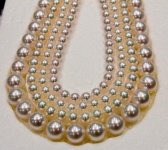I've been looking to buy a strand of white SSP necklace and I always ask sellers if the colour or lustre of the pearls have been enhanced or treated in any way. I'm more than a bit perplexed by the answers I've been given and am hoping that the experts here would be able to help.
A seller had said that almost 100% of all SSPs have been bleached to achieve a "balanced" colour and therefore the bleaching is not even considered a discloseable form of treatment. Another seller said white SSPs cannot be treated in any way or form and therefore I should not even be asking for a representation that SSPs have not been enhanced or treated.
I do not believe either of these sellers.
But I'm interested in finding out whether (i) it is reasonable for me to get a representation that the colour and lustre of the SSPs have not been enhanced or treated in any way; (ii) there are any acceptable forms of treatment that white SSPs are usually subject to which would not cause the SSPs to deteriorate over time; (iii) there is an easy test I can subject the pearls to to see if they have been enhanced or treated without having to bring the pearls to a gemologist.
As further background to my questions, I've noticed that the good quality SSP strands I've seen about 5 to 10 years ago tend to exhibit a beautiful satiny warm lustre (which I've come to associate with SSPs) with individual pearls showing very very slight variations in lustre and overtones, but the recent strands I've seen appear to exhibit a sharp metallic, often uniform lustre. I can't seem to reconcile how artificial some of these strands look and therefore my questions on enhancements. Just to clarify, I believe I can differentiate between SSPs and premium freshwater pearls (which can exhibit a beautiful sharp lustre), so it's not like the sellers are trying to deceive me into buying freshwaters passed off as SSPs.
Thanks in advance!
A seller had said that almost 100% of all SSPs have been bleached to achieve a "balanced" colour and therefore the bleaching is not even considered a discloseable form of treatment. Another seller said white SSPs cannot be treated in any way or form and therefore I should not even be asking for a representation that SSPs have not been enhanced or treated.
I do not believe either of these sellers.
But I'm interested in finding out whether (i) it is reasonable for me to get a representation that the colour and lustre of the SSPs have not been enhanced or treated in any way; (ii) there are any acceptable forms of treatment that white SSPs are usually subject to which would not cause the SSPs to deteriorate over time; (iii) there is an easy test I can subject the pearls to to see if they have been enhanced or treated without having to bring the pearls to a gemologist.
As further background to my questions, I've noticed that the good quality SSP strands I've seen about 5 to 10 years ago tend to exhibit a beautiful satiny warm lustre (which I've come to associate with SSPs) with individual pearls showing very very slight variations in lustre and overtones, but the recent strands I've seen appear to exhibit a sharp metallic, often uniform lustre. I can't seem to reconcile how artificial some of these strands look and therefore my questions on enhancements. Just to clarify, I believe I can differentiate between SSPs and premium freshwater pearls (which can exhibit a beautiful sharp lustre), so it's not like the sellers are trying to deceive me into buying freshwaters passed off as SSPs.
Thanks in advance!

